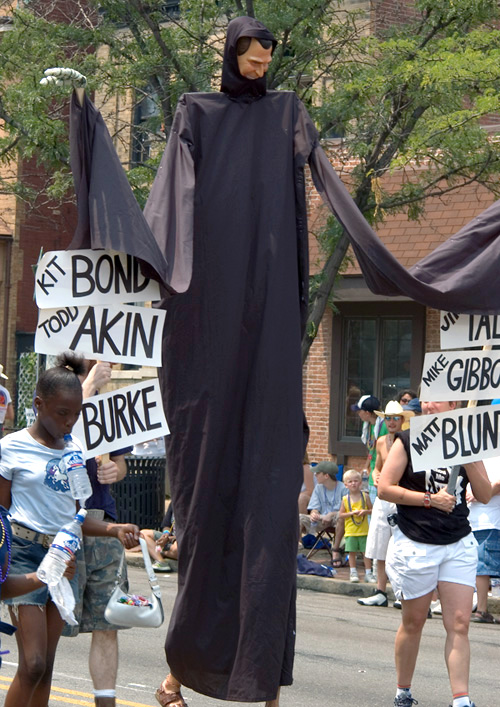The weather continues too hot to do more than walk from the door to your car and back again. As it is, I park down the hill and feel faint walking back. Tomorrow, they’ve issued a heat advisory, and the local weather people are predicting that we’ll have actual temperatures of 100 degrees; with the humidity, we could looking at 110 or more heat index. This is killer weather–it kills the spirit as readily as it destroys plants.
Even our birds are impacted by the heat. My roommate watched an infant bird in our finch garden trying to get fed by an adult bird. As the adult would hop away to get more food, two other young birds would jump on the youngster’s back, trying to peck its eyes out. The drought and extreme weather have triggered the animals naturally aggressive tendencies to compete for limited food and water. The baby will have to grow up quickly; mother nature is not feeling kind this summer.
Summer of the dead aside, I can’t fault the little guy for continuing to demand food even though he’s big enough to feed himself. All animals, including humans, especially humans, resist weaning. After all, why should we give up a nice, steady supply of tasty food in order to have to scavenge for ourselves; whether the food we’re rooting around for is seeds in dirt or Cheerios on plastic.
Reminds me of an old, old term. Have you all heard of sugar tits? I’m not sure how regional this term is, but if you haven’t heard of it before, a sugar tit is sugar wrapped in a cloth, soaked in water, and given to a baby to suck. Another old-time variation is a mixture of butter and sugar, again tied up in a cloth. A modern sugar tit is a pacifier, or sucky, dipped in sugar and given to a child–especially a child who is currently being weaned but still fussy.
Zora Neal Hurston mentions sugar tits in her story, “The Gilded Six-Bits”, a powerful short story about the lure of gold, metal that shines and glitters like the sparkle of sugar sprinkled on flour sack cotton–glittering like naked need reflected in the mirror.
The hours went past on their rusty ankles. Joe still and quiet on one bed rail and Missie May wrung dry of sobs on the other. Finally the sun’s tide crept upon the shore of night and drowned all its hours. Missie May with her face stiff and streaked towards the window saw the dawn come into her yard. It was day. Nothing more. Joe wouldn’t be coming home as usual. No need to fling open the front door and sweep off the porch, making it nice for Joe. Never no more breakfast to cook; no more washing and starching of Joe’s jumper-jackets and pants. No more nothing. So why get up?
With this strange man in her bed, she felt embarrassed to get up and dress. She decided to wait till he had dressed and gone. Then she would get up, dress quickly and be gone forever beyond reach of Joe’s looks and laughs. But he never moved. Red light turned to yellow, then white.
From beyond the no-man’s land between them came a voice. A strange voice that yesterday had been Joe’s.
“Missie May, ain’t you gonna fix me no breakfus’?”
She sprang out of bed. “Yeah, Joe. Ah didn’t reckon you wuz hongry.”
No need to die today. Joe needed her for a few more minutes anyhow.
I don’t think we outgrow the need for sugar tits though the form they take changes over time–usually become more sophisticated, and hence, more expensive, fattening, or generally bad for you in some way. When we’re unhappy or worried, it’s natural to reach out for and hold on to what gives you comfort: whether it be a macaroni and cheese casserole, chocolate, a drink, a new red convertible or an old white lover.
Years ago, I used to go to the rock shop and buy a new rock when I was unhappy. I ended up with quite a collection, which I had to auction off on eBay last year. It was devastating to have to sell the collection, but if you can’t let something go when you have real need, then you’re not much different than a fretty baby sucking on an old cotton flour sack.
Still, last couple of times out on hikes, I found myself picking up a couple of rocks, with tiny grains of quartz in them that sparkled in the sun. The good thing about these new rocks, though, is they have no intrinsic value other than my own interest; therefore I’ll never have a reason to sell them.
My Dad who died last year was a man who had little tolerance for being dependent on things. By the time he passed away, he’d stripped most of the possessions from his life until he could live in a small, two room retirement apartment. About the only things he cherished at that point were his books, his tea, and the carved wood walking stick I gave him. I have it now, the only thing I asked for from my brother when Dad moved on.
My Mom, though, I swear she holds on to stuff until the crap is dust. And then she’ll shellac it.
She shops at Wal-Mart, too. I’m disappointed by this because Wal-mart is the biggest sugar tit of all time. But, she says, it’s so cheap to buy things there. Doesn’t matter how many times I talk about laid off US workers, and abused employees and slave labor in China, she still goes back. Those two gallon jugs of pickles are a mighty lure.
One woman’s pickles, however, is another’s shiny white plastic. When Apple released iTunes podcasting support today, many of the same people who decried yesterday’s Supreme Court decisions about broadband on cable and the Grokster decision excitedly latched onto this new variation of RSS. Universally, the move is seen as a good one, even if there are concerns about the implementation. Whatever promotes the use of syndication and/or podcasting, has to be, must be, a good thing.
Even if it’s a bandwidth intensive technology that feeds the need for broadband, created by a company that has the seal of approval by the RIAA.
As for me, I used to spend money all the time. When my computers were two years old, I’d buy new ones. When new types of televisions came out, I’d buy the latest. If I was attracted to a pretty crystal statue, it usually ended up in my curio. I had, by the time I was finished, three curios stuffed full of stuff. I made a lot of money, and spent it as fast as I brought it in. I sometimes wonder if my eternal search for stuff died when the good times ended; or did I stop pursuing the good times, because in the end I found that lots of stuff means lots of stuff to dust, and not much else.
Woman’s eternal quest for truth: which dies first, the ambition, or the tits?
Most of the stuff is gone, now. I have found it easy to give up things, but less easy to give up possibilities. Doesn’t sound like a bad thing to hold on to: possibilities. But the hope of a possibility can keep you going long past the time when you should let it go.

 Today’s outing to the St. Louis PrideFest 2005 parade did not begin auspiciously–we were hit from behind by a lady driving an SUV. Luckily my roommate, who was giving me a lift, drives a larger van and we could drive away after the insurance cards were exchanged.
Today’s outing to the St. Louis PrideFest 2005 parade did not begin auspiciously–we were hit from behind by a lady driving an SUV. Luckily my roommate, who was giving me a lift, drives a larger van and we could drive away after the insurance cards were exchanged.



